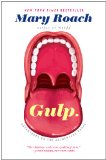Summary | Excerpt | Reviews | Beyond the Book | Readalikes | Genres & Themes | Author Bio

Adventures on the Alimentary Canal
by Mary RoachIntroduction
In 1968, on the Berkeley campus of the University of California, six young men undertook an irregular and unprecedented act. Despite the setting and the social climate of the day, it involved no civil disobedience or mind-altering substances. Given that it took place in the nutritional sciences department, I cannot even say with confidence that the participants wore bell-bottomed pants or sideburns of unusual scope. I know only the basic facts: the six men stepped inside a metabolic chamber and remained for two days, testing meals made from dead bacteria.
This was the fevered dawn of space exploration; NASA had Mars on its mind. A spacecraft packed with all the food necessary for a two-year mission would be impracticably heavy to launch. Thus there was a push to develop menu items that could be "bioregenerated," that is to say, farmed on elements of the astronauts' waste. The title of the paper nicely sums the results: "Human Intolerance to Bacteria as Food." Leaving aside the vomiting and vertigo, the thirteen bowel movements in twelve hours from Subject H, one hopes the aesthetics alone would have tabled further research. Pale gray Aerobacter, served as a "slurry," was reported to be unpleasantly slimy. H. eutropha had a "halogen-like taste."
Some in the field looked askance at the work. I found this quote in a chapter on fabricated space foods: "Men and women . . . do not ingest nutrients, they consume food. More than that, they . . . eat meals. Although to the single-minded biochemist or physiologist, this aspect of human behavior may appear to be irrelevant or even frivolous, it is nevertheless a deeply ingrained part of the human situation."
The point is well taken. In their zeal for a solution, the Berkeley team would appear to have lost a bit of perspective. When you can identify the taste of street lighting, it may be time to take a break from experimental nutrition. But I wish to say a word in defense of the "single-minded biochemist or physiologist." As a writer, I live for these men and women, the scientists who tackle the questions no one else thinks—or has the courage—to ask: the gastric pioneer William Beaumont, with his tongue through the fistulated hole in his houseboy's stomach; the Swedish physician Algot Key-Åberg, propping cadavers in dining room chairs to study their holding capacity; François Magendie, the first man to identify the chemical constituents of intestinal gas, aided in his investigation by four French prisoners guillotined in the act of digesting their last meal; David Metz, the Philadelphia dyspepsia expert who shot X-ray footage of a competitive eater downing hotdogs two at a time, to see what it might reveal about indigestion; and, of course, our Berkeley nutritionists, spooning bacteria onto dinnerware and stepping back like nervous chefs to see how it goes. The meals were a flop, but the experiment, for better or worse, inspired this book.
When it comes to literature about eating, science has been a little hard to hear amid the clamor of cuisine. Just as we adorn sex with the fancy gold-leaf filigree of love, so we dress the need for sustenance in the finery of cooking and connoisseurship. I adore the writings of M. F. K. Fisher and Calvin Trillin, but I adore no less Michael Levitt ("Studies of a Flatulent Patient"), J. C. Dalton ("Experimental Investigations to Determine Whether the Garden Slug Can Live in the Human Stomach"), and P. B. Johnsen ("A Lexicon of Pond-Raised Catfish Flavor Descriptors"). I'm not saying I don't appreciate a nice meal. I'm saying that the human equipment—and the delightful, unusual people who study it—are at least as interesting as the photogenic arrangements we push through it.
Yes, men and women eat meals. But they also ingest nutrients. They grind and sculpt them into a moistened bolus that is delivered, via a stadium wave of sequential contractions, into a self-kneading sack of hydrochloric acid and then dumped into a tubular leach field, where it is converted into the most powerful taboo in human history. Lunch is an opening act.
Excerpted from Gulp: Adventures on the Alimentary Canal by Mary Roach. Copyright © 2013 by Mary Roach. With the permission of the publisher, W.W. Norton & Company, Inc.
Your guide toexceptional books
BookBrowse seeks out and recommends the best in contemporary fiction and nonfiction—books that not only engage and entertain but also deepen our understanding of ourselves and the world around us.